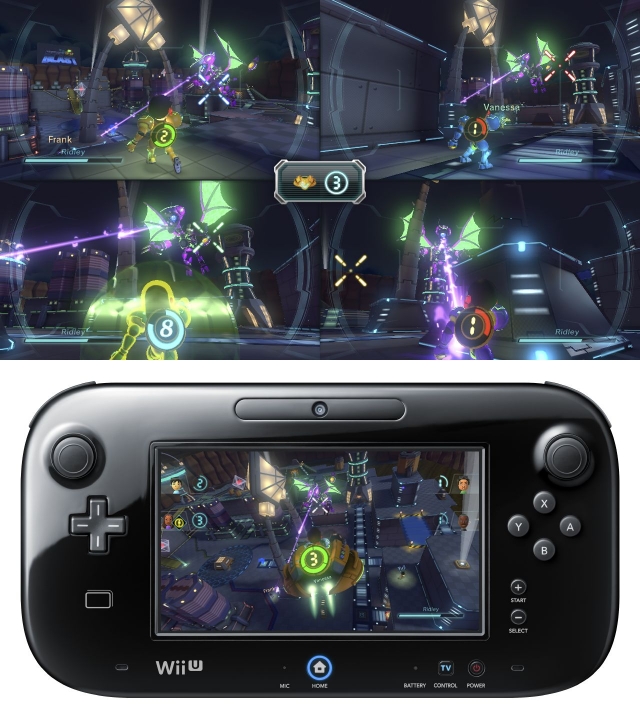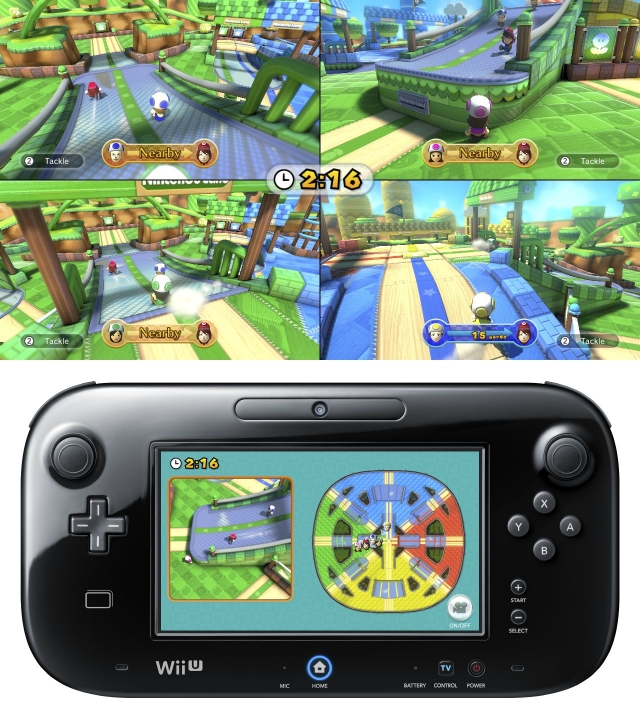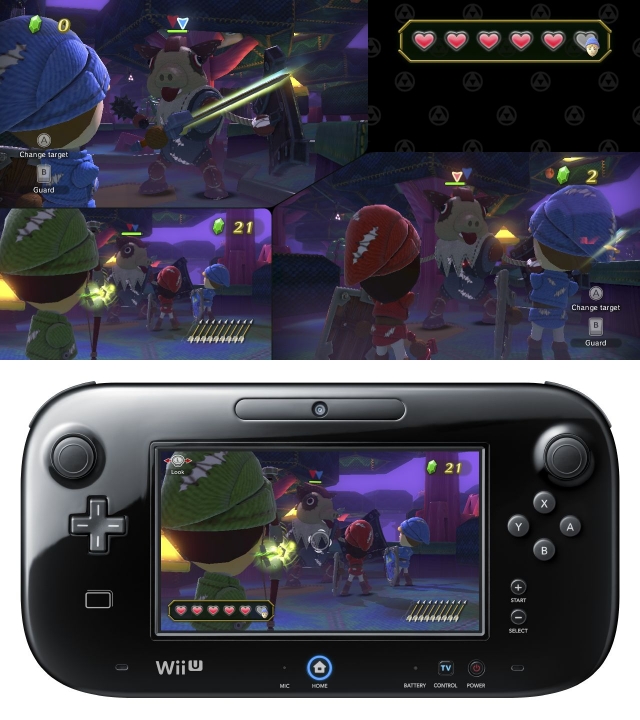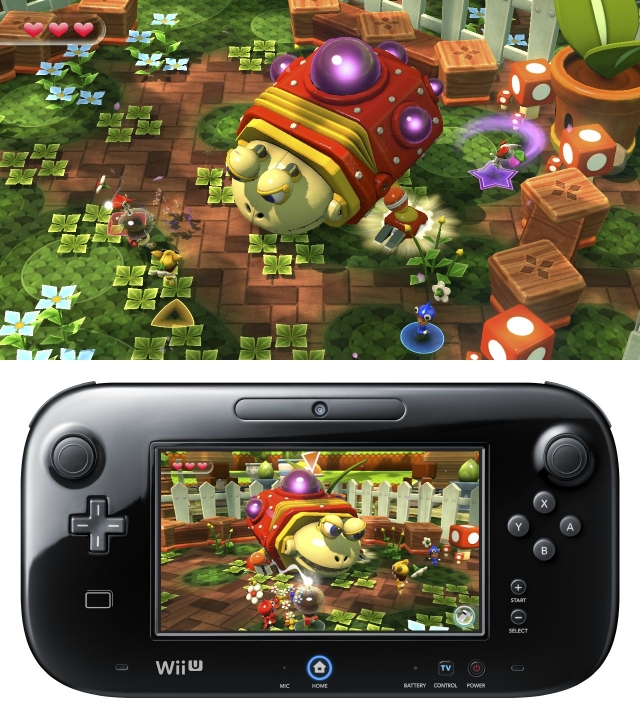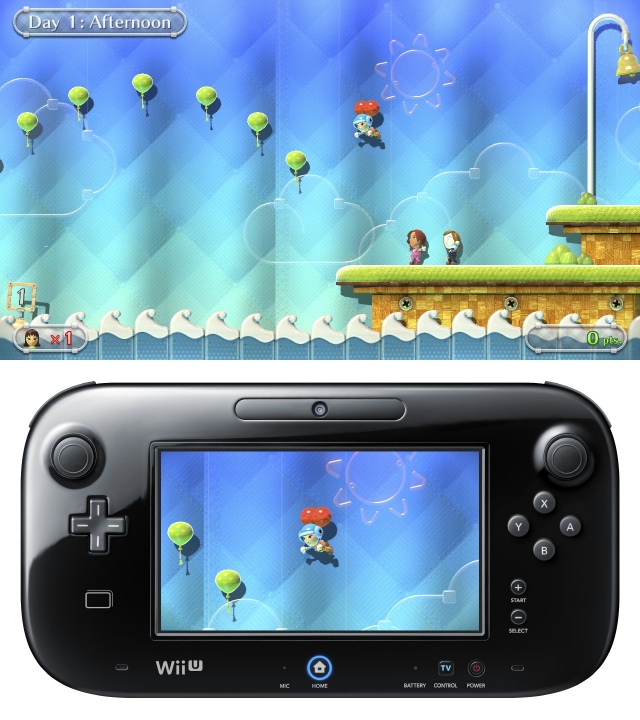Nintendo Land Review
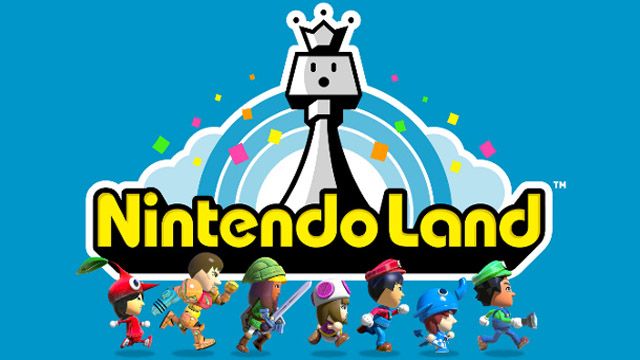
When Nintendo launched the Wii back in 2006, motion control was a revolutionary and novel concept. People simply could not wait to get their grubby hands on those shiny, white remotes and start swinging them around their living rooms. To allow them to do this, and to show off what the controls could do, Nintendo packed a game call Wii Sports in with the system. It was a collection of sports games that demonstrated the motion controls to perfection, and it was very well received.
Now, six years later, Nintendo has launched the Wii U, and they are officially out in the wild. Of course, it wouldn’t be a Nintendo launch without a new control strategy, and this iteration’s scheme is a controller called the “Gamepad” which contains a sizable touch screen, flanked by traditional dual-analog stick controls. And this time around, to show off the capabilities of the system and the new Gamepad, they’ve packaged the Deluxe version with Nintendo Land.
So, does Nintendo Land live up to the high standard that Wii Sports set six years ago? And is it a worthwhile experience in its own right? The answer is yes.
At its foundation, this is a mini-game compilation. That being said, Nintendo has done a great job of disguising this fact within a broader experience. The premise is very simple. The game is set in a theme park that houses all of the various games as “attractions.” You can run, jump, and mingle your way around the circular park filled with other Miis and check out which games are available. You’re even given a robot assistant who will help you get used to the environment and show you around. It’s all very inviting and charming in a very distinctly Nintendo way. However, the real fun starts when you jump into the games.
These aren’t just random games, either. The set list is filled with Nintendo IPs new and old, from Mario to Zelda, and from Animal Crossing to Metroid. Nintendo fans will be pleased. There are twelve games in all, including a mix of single player and multiplayer (local only). Six of the games focus on a single player experience, while the other six are meant for multiplayer in some form or fashion, whether competitive or cooperative. The multiplayer-focused games are where the new control schemes get their time in the sun, and we as players get to experience the potential of the Gamepad’s screen firsthand.
The best way to describe how this game looks and sounds is to use a word I already have once – charming. Everything is bright and colorful, and the Mii characters milling about give it a modern and kiddish look. There is plenty of Nintendo nostalgia to go around as well. For example, each game is marked with the symbol of the franchise on the gate above each attraction. Seeing the famous Zelda triforce we all know so well from across the park is just fun.
The best way to review the gameplay here will be to simply walk through the games, with a brief synopsis and impression of each. Overall, I can’t say that the game is easy or hard, because each game is different. Some are legitimately tough grinds, such as Zelda. Some, however, such as Mario Chase, are strictly for fun with friends and present no “challenge” whatsoever.
The first game that most will want to jump into (and will spend most of their time when friends are around) is Mario Chase. In this game, one player uses the Gamepad to control Mario, and other players (up to four) use Wii Remotes to control Toads. The Toads’ job is simple – catch and tackle Mario. The catch is that the Toads have only the TV screen to look at, with a meter of how far away they are from Mario. The Mario player, on the other hand, plays strictly from the Gamepad, and can see a radar image of where the Toads are in order to steer clear and survive for the allotted time. If one of the Toads catches Mario, the Toads win, and if they don’t, Mario wins. It’s that simple, and that’s what makes it so much fun. It makes for some frantic yelling and screaming as that clock starts to wind down – it’s a blast. The maps can best be described as comparable to Mario Kart battle maps.
Let’s move on to Mario’s partner, and talk about Luigi’s Ghost Mansion. In this game, the Luigis use flashlights to light the way and zap the health from a target ghost. Again, the one person using the Gamepad is the target ghost. The stages are incredibly complex and tricky, making for plenty of multiplayer frustration (the good kind!). If you can find 4-5 players for this one, it might just be the most fun of them all.
Animal Crossing: Sweet Day has the Gamepad player chasing the others around while they try to clear the map of all of the treats, whose animal heads happen to continue to grow as they consume. It’s extremely goofy to be sure, but good fun. This is the most challenging Gamepad role, since you have to control two different chasers with the two analog sticks. It takes some getting used to and is a serious exercise in hand-eye coordination.
The three previous games represent the competitive portion of the multiplayer action. The next three represent the cooperative multiplayer segment. First up is The Legend of Zelda: Battle Quest. Very simply, one player uses the Gamepad to shoot arrows at the oncoming enemies, while the other uses a Remote to swing a sword at the baddies. It’s an on-rails affair, with the only control being aiming and swinging/shooting. The game is beautiful to look at and extremely challenging. The 15+ levels provide an increasingly brutal challenge as the two players must coordinate an attack strategy and make it through each stage.
Metroid Blast is arguably the pride of Nintendo Land. It’s big, pretty, and fun, and allows a good variety of things to do. In Metroid Blast, the Gamepad player controls a spaceship that flies around the arena, shooting its blaster and missiles at the evil robot bad guys, while the Remote/Nunchuck users control infantry, running around with blasters on ground level. Players can of course fight against each other, but the most fun is working through the twenty or so co-op levels as a team. There are some unique co-op elements thrown in, such as the ability for the infantry player to latch on to the Gamepad player’s ship and be carried around while continuing to fire away. The controls here are complex, so this is certainly the game that will attract the older crowd – not the five-year-old kids who want to run around chasing Mario. But to the experienced gamer, this is an awesome addition to play as a team.
The best game of the package we haven’t covered yet is Pikmin Adventure, probably the meatiest game in Nintendo Land. With the Gamepad, you’ll take control of Olimar and go through the familiar exercise of hurling your Pikmin at the bad guys using the touch screen, while the Remote players can play as Miis, using their leaf to hit the appropriate enemies. There are 16 levels of this, after which you unlock the versus mode, which lets Olomar try to defeat the waves of enemies faster than the Pikmin. It’s exciting, engaging, and great with friends, and battles Luigi’s Ghost Mansion and Metriod Blast for the top experience in Nintendo Land.
If you’re anything like me, you’ll spend the majority of your time in the attractions we’ve talked about up to this point. Having said that, there certainly is some quick fun to be had in the rest of the games – those that I would call true “minigames.” Captain Falcon’s Twister Race is a simple racing game in which you rotate the Gamepad to keep the track in line with your ship (you’re actually steering the track, not your ship).
Takamaru’s Ninja Castle is a stage-based shooter in which you hold the Gamepad long-ways toward the TV, and use it as an aiming device. You’ll then flick upward on the touch screen to throw ninja stars at the evil ninjas until you pass each level. The touch screen is the highlight here, as it does an excellent job of reading your aim as well as the force of your flick, which determines how hard the ninja star is thrown. Bad guys will throw projectiles and bombs at you, which you can of course shoot out of the air. It’s a tribute to all stationary shooters, and it just may be the best of this bunch.
Octopus Dance is a rhythm game that forces you to remember actions and perform them by switching between the TV and Gamepad. This one, as opposed to Ninja Castle, may just be the most forgettable of this bunch.
Balloon Trip Breeze is perhaps the most simple offering in Nintendo Land, as your only job is to touch the Gamepad’s screen to produce gusts of wind that move your Mii around the screen to pop all of the balloons while avoiding obstacles. It’s fun enough, but almost too simple.
Donkey Kong’s Crash Course uses the Gamepad’s gyroscope, tilting back and forth to guide a kart through a vertical maze, from the top to the bottom. This particular game can best be described as frustrating. Only the most determined players will have the gumption to get through this without throwing the Gamepad out of the window.
Finally, Yoshi’s Fruit Cart has the player drawing a path out on the Gamepad to collect fruits. The trick is that the fruits are only visible on the screen so coordinating between the two is paramount to success. Again, fun, but shallow.
These games make up a package that, I believe, makes the Deluxe package worth picking up, but also warrants a purchase if you bought the Basic version of the Wii U. Mario Chase, Luigi’s Ghost Mansion, and Metroid Blast alone are worth the price of admission, and the rest are icing on the cake.
This may not be game of the year, but it doesn’t try to be. What it does try to be is an ode to Nintendo’s rich history and an introduction to the Wii U’s capabilities and control potential. In those efforts, it succeeds greatly.
Reviewed By: Dan Nielson
Publisher: Nintendo
Rating: 85%
——————————————————————————–
This review is based on a copy of Nintendo Land for the Wii U purchased by the reviewer.
 Game Over Online
Game Over Online